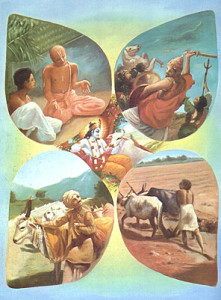Hare Krishna.
30th July, 2014, Gurgaon.
Q: What is varṇāśrama-dharma ?
Ans : Lord Krishna says in BG 4.13
cātur-varṇyaṁ mayā sṛṣṭaṁ guṇa-karma-vibhāgaśaḥ
tasya kartāram api māṁ viddhy akartāram avyayam
According to the three modes of material nature and the work associated with them, the four divisions of human society are created by Me. And although I am the creator of this system, you should know that I am yet the nondoer, being unchangeable.
Srila Prabhupada writes in his purport that ‘The Lord is the creator of everything…He is therefore the creator of the four divisions of the social order, beginning with the intelligent class of men, technically called brāhmaṇas due to their being situated in the mode of goodness. Next is the administrative class, technically called the kṣatriyas due to their being situated in the mode of passion. The mercantile men, called the vaiśyas, are situated in the mixed modes of passion and ignorance, and the śūdras, or laborer class, are situated in the ignorant mode of material nature…. The tendency of a particular man toward work is determined by the modes of material nature which he has acquired.’
Q: What is the purpose of varṇāśrama-dharma ?
Ans: It is a gradual system to purify conditioned souls who are inimical to the Supreme Lord.
Srila Prabhupada writes in the purport of cc madhya 22.142
‘The varṇāśrama institution is planned in such a way that one will not commit sinful activities. Material existence continues due to sinful activity. When one acts sinfully in this life, he gets a suitable body for the next life. When one again acts sinfully, he takes on another material body. In this way one is continuously under the influence of material nature.’
SB 11.5.2 says
śrī-camasa uvāca
mukha-bāhūru-pādebhyaḥ
puruṣasyāśramaiḥ saha
catvāro jajñire varṇā
guṇair viprādayaḥ pṛthak
Translation
Śrī Camasa said: Each of the four social orders, headed by the brāhmaṇas, was born through different combinations of the modes of nature, from the face, arms, thighs and feet of the Supreme Lord in His universal form. Thus the four spiritual orders were also generated.
Purport
Those who are not spontaneously attracted to the devotional service of the Lord can be gradually purified by observing the varṇāśrama system of four social orders and four spiritual orders. According to Śrīdhara Svāmī, the brāhmaṇas are born of the mode of goodness, the kṣatriyas of a combination of goodness and passion, the vaiśyas of a combination of passion and ignorance and the śūdras of the mode of ignorance. Just as the four social orders are born from the face, arms, thighs and feet of the Lord’s universal form, similarly the brahmacārīs are generated from the heart of the Lord, the householder order from His loins, the vānaprasthas from His chest and the sannyāsa order from His head.
A similar verse is found in the Ṛk-saṁhitā (8.4.19), as well as the Śukla-yajur Veda (34.11) and the Atharva Veda (19.66):
brāhmaṇo ‘sya mukham āsīd
bāhū rājanyaḥ kṛtaḥ
ūrū tad asya yad vaiśyaḥ
padbhyāṁ śūdro ‘jāyata
“The brāhmaṇa appeared as His face, the king as His arms, the vaiśya as His thighs, and the śūdra was born from His feet.”
It is understood that pure devotional service to the Lord has already been described by two of the Yogendras, Drumila and Āvirhotra. Camasa Muni now describes the system of varṇāśrama-dharma, because this system is meant to gradually purify those who are inimical to the Supreme Lord, bringing them back to their constitutional position of love of Godhead.
Similarly, the virāṭ-rūpa, or universal form of the Lord, is an imaginary form meant to help the gross materialists gradually understand the position of the Personality of Godhead. Since the foolish materialist cannot understand anything beyond matter, he is encouraged to see the entire universe as a personal form of the Supreme Lord’s body. The impersonal conception of formlessness is a mere negation of temporary material variety without any concept of the Lord’s spiritual potency. The impersonal view is another kind of material speculative conception. The Supreme Lord is full of spiritual potencies under the principal headings hlādinī, or unlimited bliss, sandhinī, or eternal existence, and saṁvit, or omniscience. It is understood from this verse that the varṇāśrama-dharma system generated from the universal form of the Lord is a program offered by the Lord to engage the conditioned souls in a complete social and religious system that gradually brings them back home, back to Godhead.
Q: What is the word of caution in varṇāśrama-dharma ?
Ans : Mahāprabhu tells Sri Sanatana Goswami in cc madhya 22.112
‘If one simply maintains an official position in the four varṇas and āśramas but does not worship the Supreme Lord Viṣṇu, he falls down from his puffed-up position into a hellish condition.’
Q: Which Varna and ashrama do the devotee fall into ?
Ans : Srila Prabhupada writes in the purport of BG 4.13 ‘A person in Kṛṣṇa consciousness, however, is above even the brāhmaṇas. Although brāhmaṇas by quality are supposed to know about Brahman, the Supreme Absolute Truth, most of them approach only the impersonal Brahman manifestation of Lord Kṛṣṇa. But a man who transcends the limited knowledge of a brāhmaṇa and reaches the knowledge of the Supreme Personality of Godhead, Lord Śrī Kṛṣṇa, becomes a person in Kṛṣṇa consciousness – or, in other words, a Vaiṣṇava. And as Kṛṣṇa is transcendental to this system of the four divisions of human society, a person in Kṛṣṇa consciousness is also transcendental to all divisions of human society, whether we consider the divisions of community, nation or species.’
All glories to Sri Guru and Sri Gauranga.
All glories to Srila Prabhupada.

